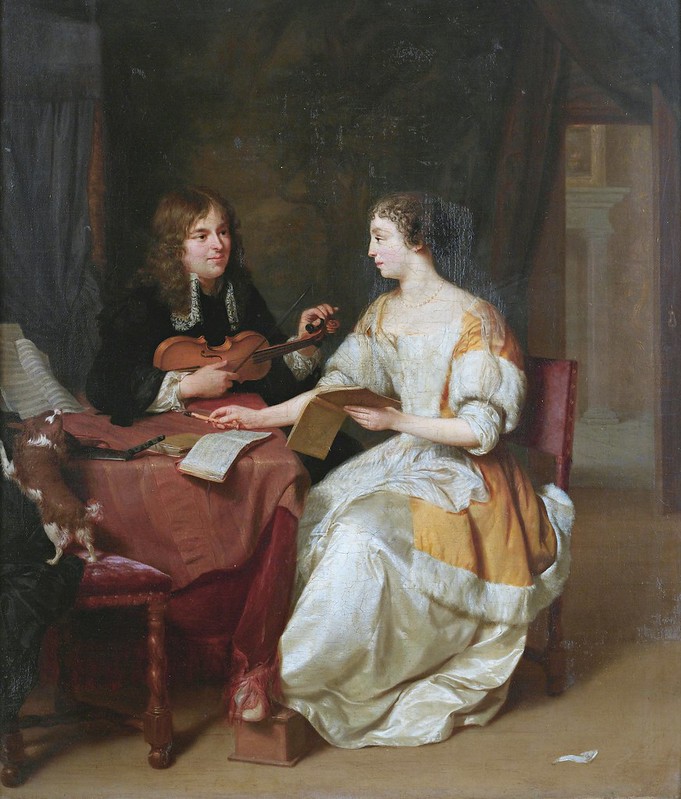Obra de Jan Verkolje (1650-1693), pintor holandès (1)
Parlem de Pintura...
Jan Verkolje (Amsterdam, bap. 27 de febrer de 1650 - Delft, 8 de maig de 1693) va ser un pintor holandès. Fill de Benjamin Verkolje, segons Arnold Houbraken es va formar amb Jan Andries Lievens, al taller de qui va ajudar a acabar diverses obres mitològiques de Gerrit Pietersz van Zijl. El 1672 va viatjar a Delft, ciutat on vivia Judith Voorheul, amb qui es va casar l’octubre d’aquell mateix any. Amb ella va tenir 5 fills, dos dels quals, Nicolaes Verkolje i Johannes Verkolje (1683-1760), van ser pintors. El 1673 va entrar al Gremi de Sant Lluc de la ciutat, on hi va servir com a pintor entre els anys 1677 i 1688. Allà va tenir nombrosos alumnes entre els quals van destacar Albertus van der Burch (b. 1672), Joan van der Spriet, Thomas van der Wilt i Willem Verschuuring. Jan Verkolje va morir a Delft el maig de 1693.
Font: En català: No disponible - En castellano: No disponible - In english: Jan Verkolje (1650-1693) - Altres: Jan Verkolje (1650-1693)
Parlem de Música...
Cataldo Amodei (Sciacca, c.1650 - Napoli, c.1695) va ser un compositor italià. De ben petit va viatjar a Nàpols on va rebre formació musical i on va decidir viure-hi la resta de la seva vida. Va treballar com a maestro del coro de San Paolo Maggiore i posteriorment al Conservatorio di San Onofrio (1681-1688). El 14 de setembre de 1687 va ser nomenat segon mestre de capella del Conservatorio di Santa Maria di Loreto. El 1689 va renunciar als seus càrrecs sent substituït per Alessandro Scarlatti. Com a compositor va compondre principalment obra vocal, dedicant el seu Primo libro de' mottetti (1679) a l’emperador Leopold I d’Àustria. Al seu temps va ser molt admirat i reconegut a Nàpols i va rebre condecoracions de les autoritats locals. Posteriorment, el seu rastre es va perdre i se creu que va morir a Nàpols a l’entorn del 1695.
OBRA:
Vocal religiosa:
Orats:
L'innocenza infetta dal pomo, 1685;
Il flagello dell'empietà, 1685;
La Susanna, 1686;
Il trionfo della purità di Maria, 1687;
Il Giosuè vittorioso: all perf. in Naples, music lost, libs I-MOe, Nc, Nn, Pci
Others:
Primo libro de' mottetti, 2–5vv, op.1 (Naples, 1679)
Cantate, libro primo, 1v, op.2 (Naples, 1685)
Cants., 3vv, spiritual canzoni, other sacred works, pastorali, duets, 2vv, bc, Nf
Instrumental:
La sirena consolata (serenata) (Naples, 1692), lost
OBRA:
Vocal religiosa:
Orats:
L'innocenza infetta dal pomo, 1685;
Il flagello dell'empietà, 1685;
La Susanna, 1686;
Il trionfo della purità di Maria, 1687;
Il Giosuè vittorioso: all perf. in Naples, music lost, libs I-MOe, Nc, Nn, Pci
Others:
Primo libro de' mottetti, 2–5vv, op.1 (Naples, 1679)
Cantate, libro primo, 1v, op.2 (Naples, 1685)
Cants., 3vv, spiritual canzoni, other sacred works, pastorali, duets, 2vv, bc, Nf
Instrumental:
La sirena consolata (serenata) (Naples, 1692), lost
Parlem en veu pròpia o en veu d'altri...
Similarly a setting such as Va’, ché l’hai fatto a me is notable for its intensity and compression – and lest one gives the impression that Amodei preferred Arcadian Vocalise, he lets rip with a taxing fast section in Già col manto dell’ombre. He learned what, say Caldara learned from Alessandro Scarlatti, in terms of pictorialism and close attention to textual detail. We can hear this in the fluttering and expressive melsimatic lines of Colà dove il Sebeto. The disc is happily rounded out with one work each by little known composers Zamboni and Storace, so little known in fact that we know neither the years of their birth nor death. Zamboni’s Sonata for archlute is in the expected five dance movements and is effectively written with a particularly lithe and free-flowing fourth-movement Sarabanda. Storace wrote his Passacagli sopra Alamire for harpsichord solo and it formed part of his only published collection – from which we know, at least, that he worked in Messina. It’s a well-argued and cogent series of variations that shows a level of invention well above the normal. These three little-known composers receive performances of perception from three well-known interpreters of the early muse. Even Kirkby is sometimes stretched by some of Amodei’s considerable demands – in something like Va’, ché l’hai fatto a me the technical difficulties in the higher register are pronounced. Altogether however BIS have uncovered a notable composer and brought him back to sometimes startling life.
Jonathan Woolf (source/font: aquí)
Gaudiu i compartiu!
Informació addicional...
AMAZON: AMODEI, C. - Cataldo Amodei
IMSLP: No disponible
CPDL: No disponible


Cap comentari:
Publica un comentari a l'entrada